| 4/2011 - 4 |
PID Neural Network Based Speed Control of Asynchronous Motor using Programmable Logic ControllerMARABA, V. A. |
| Extra paper information in |
| Click to see author's profile in |
| Download PDF |
Author keywords
control, neural network, PID, PIDNN, PLC
References keywords
control(12), neural(6), system(5), networks(4)
Blue keywords are present in both the references section and the paper title.
About this article
Date of Publication: 2011-11-30
Volume 11, Issue 4, Year 2011, On page(s): 23 - 28
ISSN: 1582-7445, e-ISSN: 1844-7600
Digital Object Identifier: 10.4316/AECE.2011.04004
Web of Science Accession Number: 000297764500004
SCOPUS ID: 84856594182
Abstract
This paper deals with the structure and characteristics of PID Neural Network controller for single input and single output systems. PID Neural Network is a new kind of controller that includes the advantages of artificial neural networks and classic PID controller. Functioning of this controller is based on the update of controller parameters according to the value extracted from system output pursuant to the rules of back propagation algorithm used in artificial neural networks. Parameters obtained from the application of PID Neural Network training algorithm on the speed model of the asynchronous motor exhibiting second order linear behavior were used in the real time speed control of the motor. Programmable logic controller (PLC) was used as real time controller. The real time control results show that reference speed successfully maintained under various load conditions. |
| References | | | Cited By «-- Click to see who has cited this paper |
| [1] Dandil B., Plant control by aid of artificial neural networks, MSc Thesis, Firat University Institute of Applied Sciences, 1997, (in Turkish).
[2] Shu, H., Pi, Y., "PID neural networks for time-delay systems", Computers and Chemical Engineering, Vol. 24, Issues 2-7, pp 859-862, 2000. [3] Bekiroglu, N., Ozcira, S., "Observerless Scheme for Sensorless Speed Control of PMSM Using Direct Torque Control Method with LP Filter", Advances in Electrical and Computer Engineering, Vol. 10, Number 3, pp. 78-83, 2010. [CrossRef] [Full Text] [Web of Science Times Cited 6] [SCOPUS Times Cited 10] [4] Laroussi, K., Zelmat, M., Rouff, M. "Implementation of a Fuzzy Logic System to Tune a PI Controller Applied to an Induction Motor", Advances in Electrical and Computer Engineering, Vol. 9, Number 3, pp. 107-113, 2009. [CrossRef] [Full Text] [Web of Science Times Cited 10] [SCOPUS Times Cited 11] [5] Sedighizadeh, M., Rezazadeh, A., "A modified Adaptive Wavelet PID Control Based on Reinforcement Learning for Wind Energy Conversion System Control", Advances in Electrical and Computer Engineering, Vol. 10, Number 2, pp. 153-159, 2010. [CrossRef] [Full Text] [Web of Science Times Cited 10] [SCOPUS Times Cited 13] [6] Shu, H., Guo, X., Shu, H., "PID neural networks in multivariable control systems", International Symposium on Intelligent Control, Vancouver, Canada, 2002. [7] Shu, H., Guo, X., "Decoupling Control of Multivariable Time-Varying Systems Based on PID Neural Network", 5th Asian Control Conference, Melbourne, Australia, 2004. [8] Shu, H., Pi, Y., "Decoupled Temperature Control System Based on PID Neural Network", ACSE Conference, Cairo Egypt, 2005. [9] Siemens S7-300 Module Data, A5E00105505-06, 08/2009. [10] Ronco E, Gawthrop P J, Neural networks for modeling and control, Centre for System and Control Department of Mechanical Engineering University of Glasgow, Technical Report csc97008, 1997. [11] Lennart Ljung, System Identification: Theory for the user, 2nd edition (Prentice Hall PTR, 1999). [12] Siemens S7-SCL V5.3 for S7-300/400 Manual, Edition 01/2005. Web of Science® Citations for all references: 26 TCR SCOPUS® Citations for all references: 34 TCR Web of Science® Average Citations per reference: 2 ACR SCOPUS® Average Citations per reference: 3 ACR TCR = Total Citations for References / ACR = Average Citations per Reference We introduced in 2010 - for the first time in scientific publishing, the term "References Weight", as a quantitative indication of the quality ... Read more Citations for references updated on 2025-05-30 09:47 in 22 seconds. Note1: Web of Science® is a registered trademark of Clarivate Analytics. Note2: SCOPUS® is a registered trademark of Elsevier B.V. Disclaimer: All queries to the respective databases were made by using the DOI record of every reference (where available). Due to technical problems beyond our control, the information is not always accurate. Please use the CrossRef link to visit the respective publisher site. |
Faculty of Electrical Engineering and Computer Science
Stefan cel Mare University of Suceava, Romania
All rights reserved: Advances in Electrical and Computer Engineering is a registered trademark of the Stefan cel Mare University of Suceava. No part of this publication may be reproduced, stored in a retrieval system, photocopied, recorded or archived, without the written permission from the Editor. When authors submit their papers for publication, they agree that the copyright for their article be transferred to the Faculty of Electrical Engineering and Computer Science, Stefan cel Mare University of Suceava, Romania, if and only if the articles are accepted for publication. The copyright covers the exclusive rights to reproduce and distribute the article, including reprints and translations.
Permission for other use: The copyright owner's consent does not extend to copying for general distribution, for promotion, for creating new works, or for resale. Specific written permission must be obtained from the Editor for such copying. Direct linking to files hosted on this website is strictly prohibited.
Disclaimer: Whilst every effort is made by the publishers and editorial board to see that no inaccurate or misleading data, opinions or statements appear in this journal, they wish to make it clear that all information and opinions formulated in the articles, as well as linguistic accuracy, are the sole responsibility of the author.



